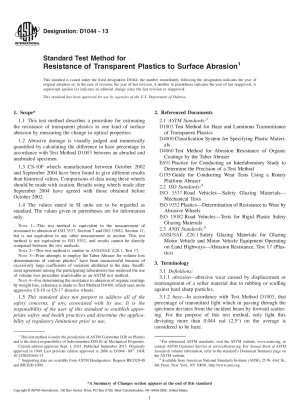ASTM D1044-13
Standard Test Method for Resistance of Transparent Plastics to Surface Abrasion
- Standard No.
- ASTM D1044-13
- Release Date
- 2013
- Published By
- American Society for Testing and Materials (ASTM)
- Status
- Replace By
- ASTM D1044-19
- Latest
- ASTM D1044-19
- Scope
4.1 Transparent plastic materials, when used as windows or enclosures, are subject to wiping and cleaning; hence the maintenance of optical quality of a material after abrasion is important. It is the purpose of this test method to provide a means of estimating the resistance of such materials to this type and degree of abrasion.
4.2 Although this test method does not provide fundamental data, it is suitable for grading materials relative to this type of abrasion in a manner which correlates with service.
4.3 Comparison of interlaboratory data or the specification of a “haze” value has no significance if the hazemeter requirements given in 5.4 are not used. This is because light diffused from the surface of a Taber track is scattered at a narrow angle (Fig. 1 and Fig. 2) while light diffused internally by a specimen is scattered at a wide angle. In many hazemeters, when a diaphragm is inserted to limit the light beam to the width of the abraded track, the specular beam at the exit port becomes smaller. The dark annulus will then be greater than the 0.023 ± 0.002 rad (1.3 ± 0.1°) requirements of Test Method D1003. Since a large percentage of the narrow-angle forward-scattered light will not impinge on the sphere wall, “haze” readings become smaller. For hazemeters that have not been properly adjusted, the magnitude of this reduction is dependent both on the integrating sphere diameter and the reduction of the entrance beam.
4.4 For many materials, there may be a specification that requires the use of this test method, but with some procedural modifications that take precedence when adhering to the specification. Therefore, it is advisable to refer to that material specification before using this test method. Table 1 of Classification System D4000 lists the ASTM materials standards that currently exist.
4.5 For some materials, abrasion tests utilizing the Taber abraser may be subject to variation due to changes in the abrasive characteristics of the wheel during testing.
4.5.1 Depending on abradant type and test specimen, the wheel surface may change (that is, become clogged) due to the transfer of coating or other materials from test specimens and must be cleaned at frequent intervals.
4.5.2 The type of material being tested and the number of test cycles being run is known to sometimes influence the temperature of the running surface of the wheel with an effect on the final haze measurement. To reduce any variability due to this temperature effect, stabilize the wheels surface temperature prior to performing actual measurements. This shall be accomplished by conducting multiple refacings on an ST-11 refacing stone, followed by a test on the sample material to be tested (with results to be discarded).
1.1 This test method describes a procedure for estimating the resistance of transparent plastics to one kind of surface abrasion by measuring the change in optical properties.
1.2 Abrasive damage is visually judged and numerically quantified by calculating the difference in haze percentage in accordance with Test Method D1003 between an abraded and unabraded specimen.
1.3 CS-10F wheels manufactured between October 2002 and September 2004 have been found to give different re......
ASTM D1044-13 Referenced Document
- ANSI/SAE Z26.1 Safety Glazing Materials for Glazing Motor Vehicles and Motor Vehicle Equipment Operating on Land Highways - Safety Standard
- ASTM D1003 Standard Test Method for Haze and Luminous Transmittance of Transparent Plastics
- ASTM D4000 Standard Classification System for Specifying Plastic Materials
- ASTM D4060 Standard Test Method for Abrasion Resistance of Organic Coatings by the Taber Abraser
- ASTM E691 Standard Practice for Conducting an Interlaboratory Study to Determine the Precision of a Test Method
- ASTM G195 Standard Guide for Conducting Wear Tests Using a Rotary Platform Abraser
- ISO 15082 Road vehicles - Tests for rigid plastic safety glazing materials
- ISO 3537 Road vehicles - Safety glazing materials - Mechanical tests
- ISO 9352 Plastics - Determination of resistance to wear by abrasive wheels
ASTM D1044-13 history
- 2019 ASTM D1044-19 Standard Test Method for Resistance of Transparent Plastics to Surface Abrasion by the Taber Abraser
- 2013 ASTM D1044-13 Standard Test Method for Resistance of Transparent Plastics to Surface Abrasion
- 2008 ASTM D1044-08e1 Standard Test Method for Resistance of Transparent Plastics to Surface Abrasion
- 2008 ASTM D1044-08 Standard Test Method for Resistance of Transparent Plastics to Surface Abrasion
- 2005 ASTM D1044-05 Standard Test Method for Resistance of Transparent Plastics to Surface Abrasion
- 1999 ASTM D1044-99 Standard Test Method for Resistance of Transparent Plastics to Surface Abrasion

Copyright ©2024 All Rights Reserved